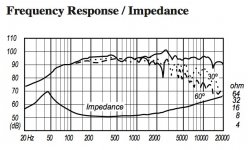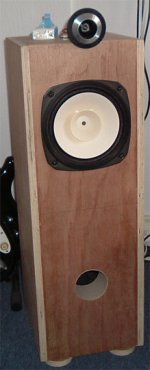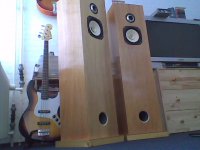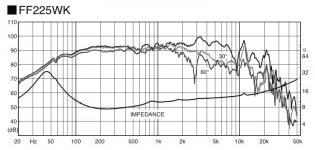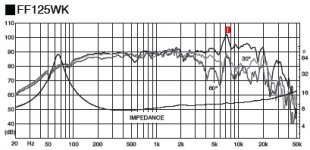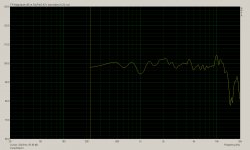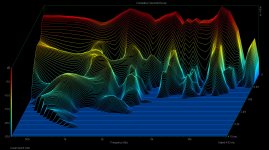I got a pair of FE207E and built the recommended single bass reflex cabinet. While the bass was decent and the efficiency good, they are unacceptable. Between approximately 2 and 5kHz there are one or more resonant peaks in the output. When a note happens to hit one of those peaks, it positively darts out and stabs the eardrum, making listening tiring and painful.
I tried breaking them in for hours and also lining the cabinets, but neither seemed to have any effect whatsoever on this problem.
Any suggestions? Could different cabinets fix this? Maybe I should upgrade to FF225WK?
I tried breaking them in for hours and also lining the cabinets, but neither seemed to have any effect whatsoever on this problem.
Any suggestions? Could different cabinets fix this? Maybe I should upgrade to FF225WK?
have you got some phase plugs in them, or tried that little trick with stuffing behind the whizzer cone?
Member
Joined 2009
Paid Member
I can sympathize with your experience. I built 5 speakers using the Fostex FE127E which has problems with uneven freq. response. They have proven to be too fatiguing for music and currently only one of them is in use and it is to be replaced.
I believe the problem is cone-breakup, resonances in the cone. I tried treating the cone with Plante10's tri-foil pattern and whilst it helped a bit, it was far from what I needed. I don't believe it's possible to fix cone break up without unacceptable trade-offs. I also tried a notch-filter and BSC network, but it didn't fix the problem and they actually made the driver sound a little lifeless. I believe these filters simply reduce the level of signal at the offensive frequencies but they can't proven the cone surface resonances.
My ears have proven to be very sensitive to cone break up resonance. I can even hear it in the CSS EL-70 which few if anybody has complained about - but it's there at around 6kHz. Perhaps you are also sensitive to this issue.
It's not easy. Not everyone (probably nobody except Mark Audio) publishes raw data, the plots you see are all smoothed. I've attached the published spec for the FE207. The bump at around 2.7 kHz is the thing that should set off alarm bells. The off-axis response shows again something unfavourable. I suspect that if the raw data had not been so smoothed this bump would actually look worse and there'd be a sharp dip just before the peak - the classic sign of a cone breakup mode. Large cones seem to suffer more from this.
They will probably improve a bit more with time - these drivers seem to take a long time to break-in so you may need to give it more time. Check that there's some absorptive material on the surface directly behind the driver so h.f. isn't reflecting back through the cone - this is important in my experience. Also make sure the screws holding the driver into the box aren't over-tightened and distorting the frame.
Also see here http://www.diyaudio.com/forums/full-range/146309-fe207-dustcap-removal-leads-roughness.html
I believe the problem is cone-breakup, resonances in the cone. I tried treating the cone with Plante10's tri-foil pattern and whilst it helped a bit, it was far from what I needed. I don't believe it's possible to fix cone break up without unacceptable trade-offs. I also tried a notch-filter and BSC network, but it didn't fix the problem and they actually made the driver sound a little lifeless. I believe these filters simply reduce the level of signal at the offensive frequencies but they can't proven the cone surface resonances.
My ears have proven to be very sensitive to cone break up resonance. I can even hear it in the CSS EL-70 which few if anybody has complained about - but it's there at around 6kHz. Perhaps you are also sensitive to this issue.
It's not easy. Not everyone (probably nobody except Mark Audio) publishes raw data, the plots you see are all smoothed. I've attached the published spec for the FE207. The bump at around 2.7 kHz is the thing that should set off alarm bells. The off-axis response shows again something unfavourable. I suspect that if the raw data had not been so smoothed this bump would actually look worse and there'd be a sharp dip just before the peak - the classic sign of a cone breakup mode. Large cones seem to suffer more from this.
They will probably improve a bit more with time - these drivers seem to take a long time to break-in so you may need to give it more time. Check that there's some absorptive material on the surface directly behind the driver so h.f. isn't reflecting back through the cone - this is important in my experience. Also make sure the screws holding the driver into the box aren't over-tightened and distorting the frame.
Also see here http://www.diyaudio.com/forums/full-range/146309-fe207-dustcap-removal-leads-roughness.html
Attachments
Last edited:
yea, you have to look closely at the freq responses to get even a start on if they will be unacceptable. I even find the peaks in the 4" bamboo drivers hard to listen to after listening to a smoother setup.
Norman
Norman
Hi Adipocere,
I had same problems with mine FE207E - after about 9 months I finally give-up ( I had to install BSC filter from MJ King ) - there are better enclosures designed to extract more bass, but I was unhappy with the midband, than 3 years later I finally built for friend of mine FE167E in MLTL design > which was miles better than FE207E but still in need for helper tweeter ( for my ears ) so I decided to say good-by to full-range speakers for now ( until I can hear ready-made example to regain my faith in full-range sound - otherwise I'm not interested in investing my money again just to try-out ).
Max
I had same problems with mine FE207E - after about 9 months I finally give-up ( I had to install BSC filter from MJ King ) - there are better enclosures designed to extract more bass, but I was unhappy with the midband, than 3 years later I finally built for friend of mine FE167E in MLTL design > which was miles better than FE207E but still in need for helper tweeter ( for my ears ) so I decided to say good-by to full-range speakers for now ( until I can hear ready-made example to regain my faith in full-range sound - otherwise I'm not interested in investing my money again just to try-out ).
Max
Attachments
Member
Joined 2009
Paid Member
Let's not give up altogether - just need to find the 'right' driver. I believe there is enough knowledge on this forum to help point the way....
AS Gareth mentioned, it's the cone resonance that produces the peaks in the response that is so annoying and using the trefoil treatment + paper coating does reduce the magnitude of the peak(s), it also changes the response/sound of the driver quite a bit.
Every cone driver made has cone resonance peaks but the heavier cone,softer material, etc, drivers just dampen the peaks out - and the smaller the diameter means the peaks are at a higher freq, hence the upper limits placed on high efficiency midrange drivers, and so on. (very broad statements here, plenty of exceptions - no flames please!)
One thing that's often ignored is the effect of the amplifier on speaker performance, and that's why many people prefer the combination of valve amps and high efficiency drivers, whether they're multiway or FR.
Over the years, there have been many and varied ways of reducing the effects of cone resonance peaks and the 'enable' method is one that has been extensively investigated and there are many variations of the technique still undergoing development.
I got a fully 'modded' Fe167 from Peter Daniels awhile back and it was a dramatic change to the original and I ended up adding a tweeter to it and it functioned very well indeed - on another Fe167, I tried adding small dots of water soluble 'paint" to the cone in a series of spirals in an attempt to duplicate the smooth response of the Scan 'W' series drivers and it was also quite reasonably successful and sound was again quite different to the original ('better' to me, IMO naturally!) - there are many other ways to do this.
The addition of a thing called a "tapered resistance tube" at the back of the speaker chamber is of great benefit to light cone high efficiency drivers - more info available on the "pro-audio" sites and the reference still seems to be the B&W Nautilus design 'white paper' from their site - you do have to do your homework.
I have found the use of "high impedance, current output" amplifiers suits high efficiency driver very well - again, some homework required.
... my 2 cents
Every cone driver made has cone resonance peaks but the heavier cone,softer material, etc, drivers just dampen the peaks out - and the smaller the diameter means the peaks are at a higher freq, hence the upper limits placed on high efficiency midrange drivers, and so on. (very broad statements here, plenty of exceptions - no flames please!)
One thing that's often ignored is the effect of the amplifier on speaker performance, and that's why many people prefer the combination of valve amps and high efficiency drivers, whether they're multiway or FR.
Over the years, there have been many and varied ways of reducing the effects of cone resonance peaks and the 'enable' method is one that has been extensively investigated and there are many variations of the technique still undergoing development.
I got a fully 'modded' Fe167 from Peter Daniels awhile back and it was a dramatic change to the original and I ended up adding a tweeter to it and it functioned very well indeed - on another Fe167, I tried adding small dots of water soluble 'paint" to the cone in a series of spirals in an attempt to duplicate the smooth response of the Scan 'W' series drivers and it was also quite reasonably successful and sound was again quite different to the original ('better' to me, IMO naturally!) - there are many other ways to do this.
The addition of a thing called a "tapered resistance tube" at the back of the speaker chamber is of great benefit to light cone high efficiency drivers - more info available on the "pro-audio" sites and the reference still seems to be the B&W Nautilus design 'white paper' from their site - you do have to do your homework.
I have found the use of "high impedance, current output" amplifiers suits high efficiency driver very well - again, some homework required.
... my 2 cents
Member
Joined 2009
Paid Member
Any suggestions? Could different cabinets fix this? Maybe I should upgrade to FF225WK?
I took a peak at the data sheet for the FF225WK (attached); unfortunately it still looks to have the tell-tale cone break up peaks in there.
The FE208EZ is another Fostex 8" but it has a peak around 3kHz that people (e.g. Mr. Brines) says needs to be notched and it has rolled off treble.
Seems the best choice is to try modifying the driver - beyond my experience but you could try contacting Dave at Planet10 - he knows a lot about this, many years of experience with full-range drivers.
http://www.planet10-hifi.com/pp-info.html
Perhaps last ditch option is to turn it into a full-range-assisted-by-a-tweeter kind of speaker. Use a low-pass filter on the FE207 and add a tweeter to handle the treble without the peakiness issues. You can readily add a tweeter to the enclosure you have built already.
http://www.diyaudio.com/forums/multi-way/38349-tweeter-suit-fostex-fe207.html
Attachments
Last edited:
I took a peak at the data sheet for the FF225WK (attached); unfortunately it still looks to have the tell-tale cone break
Actually I was able to listen to the FF225WK twice over the last week. it does not suffer from irritating aspects, in fact it is remarkably smooth and unfatigueing and in short quite a bit better in tonality than its x06E and x07e ancestors.
But, you need a tweeter, the driver has good bass but, as you can guess from the frequency plot, it lacks air in the higher frequencies.
By the way, the metal dustcap of the WK series isnt a sphere but has a ridge. I first thought: wtf? Then i read in the leaflet that came with the FF125wk that I bought that the ridge is there to prevent resonance effects.
In any case this is a good series, they were quite obviously better and more refined than comparable FEx06En in their japanese BK series horn boxes with which I could immediately compare them.
I recommend to check out the driver, and add an affordable ribbon or magnetostat tweeter. Since the 225 is so smooth I would first try to only put a filter on the tweeter.
Member
Joined 2009
Paid Member
That's encouraging news.
I do find though, that cone breakup resonances are not reported as a problem by everyone - the FE127E is pretty bad for me but proved very popular so it maybe my ears are somehow extra sensitive to this. Now - if I see a bump in the FR, I am reluctant to consider the driver as useable.
I do find though, that cone breakup resonances are not reported as a problem by everyone - the FE127E is pretty bad for me but proved very popular so it maybe my ears are somehow extra sensitive to this. Now - if I see a bump in the FR, I am reluctant to consider the driver as useable.
By the way, the metal dustcap of the WK series isnt a sphere but has a ridge. I first thought: wtf? Then i read in the leaflet that came with the FF125wk that I bought that the ridge is there to prevent resonance effects.
The ridged dustcap came from an eSR special edition. It seems to work really well.
I have been listening to the FF8wKeN for the last couple weeks (i have at least 3 other prototypes that i'm supposed to listen to, but these are so enthralling i've been reluctant to pull them out). After the 1st week i did hook up the stealthWoofers (rear-firing SDX7 in a triangular prism) to provide some bas support (no HP on the FF85).
Both the FF125 & FF165 are good too and with the capability of producing some bass on their own, better all-rounders. I've not heard FF225 yet.
They are not resonance free, but some 2-way Zig glue on the back of the cone at the surround/cone junction seems to quell much of that.
The dustcap works really well. When Bud did the reference treaments on these he did nothing to the dustcaps. I have added a tiny bit of treatment which has a small benefit (ridge runs left to right). THis can be seen in these glow-in the darl FF85eKeN. You may also note the extra ring of spots near the surround to combat the surround/cone junction issues.

dave
Member
Joined 2009
Paid Member
The ridged dustcap came from an eSR special edition. It seems to work really well.
I have been listening to the FF8wKeN for the last couple weeks (i have at least 3 other prototypes that i'm supposed to listen to, but these are so enthralling i've been reluctant to pull them out). After the 1st week i did hook up the stealthWoofers (rear-firing SDX7 in a triangular prism) to provide some bas support (no HP on the FF85).
Both the FF125 & FF165 are good too and with the capability of producing some bass on their own, better all-rounders. I've not heard FF225 yet.
They are not resonance free, but some 2-way Zig glue on the back of the cone at the surround/cone junction seems to quell much of that.
The dustcap works really well. When Bud did the reference treaments on these he did nothing to the dustcaps. I have added a tiny bit of treatment which has a small benefit (ridge runs left to right). THis can be seen in these glow-in the darl FF85eKeN. You may also note the extra ring of spots near the surround to combat the surround/cone junction issues.
dave
WOW !, do these look really fantastic in that lighting !


How did you know where to put the Zig (what the heck is Zig) ? and how would I know if it will help my FE127's ?
Would this 'fix' the FE207 ?
Also, if it's not too off topic - the 125 could be an alternative for my 127 but looks to have a big peak in the FR plots, much worse than all the other plots for it's sibling drivers - have you also cured this with the Zig ?
Last edited:
WOW !, do these look really fantastic in that lighting !
How did you know where to put the Zig (what the heck is Zig) ? and how would I know if it will help my FE127's ?
Would this 'fix' the FE207 ?
Also, if it's not too off topic - the 125 could be an alternative for my 127 but looks to have a big peak in the FR plots, much worse than all the other plots for it's sibling drivers - have you also cured this with the Zig ?
If I may offer a completely subjective impression of the 125 vis a vis 127 - to repeat what I've said about all 3 of the new WK series that I've heard 85/125/165 - I find them all improved over their immediate predecessors, each of which I've had well over 5yrs of experience.
I can't speak to the 225 /207 with or without full monty treatment . While I've heard the FE206E & ESR (neither driver or should I say the requisite enclosures quite my cuppa tea), I'm not sure at all about having heard the 207 - maybe at a show sometime, but certainly not memorable one way or the other.
Member
Joined 2009
Paid Member
to repeat what I've said about all 3 of the new WK series that I've heard 85/125/165 - I find them all improved over their immediate predecessors,
Well, unless there is something in the magic Zig... I'm looking at the FR plot for the 125 and it looks like it has the same "ask three teenagers to scream loudly in my ear" cone break up mode at the same >10dB 7kHz frequency as the FE127.... ?
Attachments
I should also mention that the FE-series drivers are best used with a highish output impedance amplifiers (typically small SE tube amps).
Adipocere, what amp are you using with the 207?
dave
Adipocere, what amp are you using with the 207?
dave
How did you know where to put the Zig (what the heck is Zig) ? and how would I know if it will help my FE127's ?
Would this 'fix' the FE207 ?
Also, if it's not too off topic - the 125 could be an alternative for my 127 but looks to have a big peak in the FR plots, much worse than all the other plots for it's sibling drivers - have you also cured this with the Zig ?
Bud discovered the mod. It isn't a fix, but it helps. FE127 was the 1st driver this was tried on -- until we get Bud his A7 boxes & his wild lowther OBs, a set of bamboo FonkenPrime are his mains.
dave
None for the FE207E, they're a bit of a lost cause IMHO. I have a pair here sitting back in their original packaging some 8 years after I bought them because the 2.6Khz resonance is unacceptably bad, and more or less untreatable, and I have certainly tried.I got a pair of FE207E and built the recommended single bass reflex cabinet. While the bass was decent and the efficiency good, they are unacceptable. Between approximately 2 and 5kHz there are one or more resonant peaks in the output. When a note happens to hit one of those peaks, it positively darts out and stabs the eardrum, making listening tiring and painful.
I tried breaking them in for hours and also lining the cabinets, but neither seemed to have any effect whatsoever on this problem.
Any suggestions?
I've attached a frequency response measurement of one of mine (only accurate above 1Khz due to a relatively small measurement gating time) and the 5dB resonance spike at 2.6Khz is very obvious, this is the main problem with these drivers and seems to be a whizzer cone resonance. Short of cutting the whizzer cone out you won't fix this resonance, as it just isn't a well designed whizzer. (For starters is conical instead of curvilinear)
There are other serious resonances as well, including some around 4-5Khz which are cone breakup of the main cone. I've attached a cumulative spectral decay as well and the resonances at both 2.6Khz and 4Khz are very obvious and it can be seen that they ring for a very long time, (nearly 4ms for the 2.6Khz one) this is what you're hearing which sounds painful to listen to.
Some people would say that a spike in the response is inevitable from a whizzer cone but its not necessarily the case when well designed, as a comparison I've also attached the response of a 40 year old vintage Coral Flat 8 II, (same test conditions, also only valid above 1Khz due to measurement gate time) also an 8" driver with an even larger whizzer cone than the FE207E, and its remarkably flatter in the 2-5Khz region with very little sign of a whizzer resonance, and just a bit of a main cone resonance at about 4.3Khz. The difference between the two drivers CSD decay is quite a stark contrast. Needless to say the Coral driver sounds far better and doesn't have the shrill ear bleeding upper midrange of the Fostex.
I know its not what you probably want to hear but I would give up on the FE207E and look for a different model of driver.
Attachments
Last edited:
Well, unless there is something in the magic Zig... I'm looking at the FR plot for the 125 and it looks like it has the same "ask three teenagers to scream loudly in my ear" cone break up mode at the same >10dB 7kHz frequency as the FE127.... ?
I listened to it for some time in the shop, switching to the 105 (as I am looking for relatively small speakers for a 2nd system), and while I expected exactly that irritating behaviour from the plots, the reality was however quite pleasant. Perhaps because that peak is at around 8 khz, it is less noticeable than the one of the 207?
It was a difficult pick vs the equally very nice 105, but I picked the 125 as it can handle a bit better bass while still being nicely extented in the treble.
A little addendum: previously I didn't like Fostex drivers that much. Yes, a lot of dynamics for the price but little subtlety in tone. The FF..WK series however sounds obviously richer and more musical, this is immediately audible when switching with the FE..6En series. A good thing of being on a business trip in Tokyo is that it is relatively easy to compare several Fostex drivers in the factory cabinets !
Due to this thread I just switched in FF125wKeN (in CIABAP -- if someone can morph that working name into something better please do). Just listening to the hockey game ATM -- will report back when i have some listening time on them.
dave
dave
- Status
- Not open for further replies.
- Home
- Loudspeakers
- Full Range
- Painful FE207E
